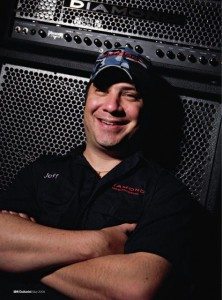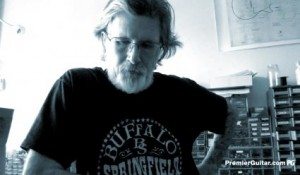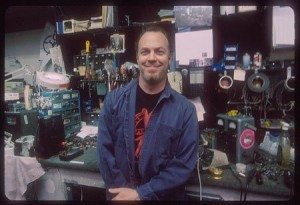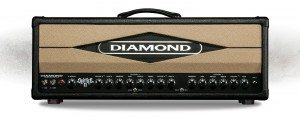Standing on the Shoulders of Giants: How a Simple Phone Call Gave Rise to a Great Modern Amp Maker
trushack | Jan 19, 2015 | Comments 0
Hopefully everyone has emerged from the holiday season unscathed. Whatever part of Chrisma-kwanz-anukah one happens to celebrate, it’s pretty likely that there are a host of established traditions that follow that help make the inherent stress of each frantic, fad-driven holiday season a little more bearable, leaving one’s sanity intact as we begin the new year. Maybe it’s watching the classic Christmas film Die Hard, noshing on Grandma’s special lasagna or responsibly enjoying Grandpa’s special bourbon (which is great any time of year, he’d surely tell us); it’s fair to say that the vast majority of people have something associated with the holidays that has endured all of the fads that have come and gone with each passing year.

Jeff Diamant – Founder Diamond Amplification & Diamond Guitars
We can find many of the same parallels in the gear world. It’s not news that there are tons of variations out there on tried-and-true designs and circuits that originated not long before Brenda Lee’s “Rockin’ Around the Christmas Tree” was burning up the airwaves, and many builders are still wowing players with their interpretations of these designs. What sets a few outstanding builders apart from the pack is how they are able to honor classic guitar, amplifier, and effect platforms while introducing their own twists and tweaks. Jef Diamant, founder of Diamond Amplification and Diamond Guitars (f/k/a DBZ/Diamond Guitars), is certainly a leader among the builders of today who are keeping yesteryear gear traditions fresh.
“At the end of the day, everything we’re doing is a variation of a Fender and a Marshall circuit. There’s nothing novel in the amp world,” Diamond recently explained to TheToneKing.com. “It’s like making spaghetti. You’ve probably had hundreds of dishes of spaghetti in your life, but at the end of the day, what makes the spaghetti good or bad is the combination of components that the chef uses. This guy has a little more of this, a little less of that, a little more of this and a little bit of that and this other guy does something different. That’s all the fuck it is. The circuit design [used for guitar amplifiers] hasn’t changed in sixty years. What changes is how we flavor it.
“The lessons of everything we’ve ever tried, experimented with, done successfully, done unsuccessfully, give us the knowledge base that we have today. In some regard, all of us have learned from some combination of the other [builders],” Diamant said.
Learning From Some of the Best
Diamant’s own brand of “spaghetti”, Diamond Amplification, has certainly won over crowds of hungry tone enthusiasts. Built upon a combination of Diamant’s drive and persistence and the connections that Diamond made in the gear world early on, Diamond Amplification quickly made a name for itself among pros and amateurs a like. Diamond Amps have found their way into balkiness as varied as Five Finger Death Punch, Godsmack, Fleetwood Mac, Kid Rock, 311 and The Wailers.
And those connections? We’re not talking about a guy at Radio Shack who helped Diamant pick out a soldering iron. We’re talking about none other than Bob Bradshaw and Martin Golub, giants in the world of musical equipment development and engineering. Sticking with our spaghetti metaphor, these guys are not Chef Boyardee. They’re famed Italian chef Massimo Bottura.

Bob Bradshaw
“So what exactly do you do?”
After spending several years behind a drum kit, Diamant moved over to exploring the guitar and ultimately into the Venus Fly Trap that is electric guitar gear. Diving into the electric guitar scene, Diamant eventually began to hear about “hot-rodded” amps and, curiosity piqued, embarked on a mission to learn more about mods and building complete electric guitar rigs. Eventually, he heard about Bob Bradshaw, master rig builder and founder of Custom Audio Electronics, and gave him a call.
Diamant’s very first question to Bradshaw, upon getting him on the phone, was simple: what exactly do you do? One could say that these very words launched what would eventually become Diamond Amplification.
“Bob and I developed a very fast friendship,” Diamant noted. If you haven’t checked out Bradshaw’s guest appearance on the October 2014 of “Guitar Gear Tech Talk”, please do so. It’ll immediately make sense. Peas in a pod, those two.

Martin Golub
“Ultimately, that [friendship] led me into a friendship with Martin [Golub],” Diamant explained. “Martin built rigs with Bob, but he was also the amp guy at Bob’s shop. Martin is famous for a lot of things, but the most notable things were the infamous Doug Aldrich Marshalls, the Reb Beach Marshalls, and most importantly the Billie Joe/Green Day ‘Dookie’ tone. The ‘Dookie’ mod became very famous…[Billie Joe’s] tone on that record was fucking crushing.”
Welcomed into the Bradshaw/Custom Audio family, Diamant dove right into learning the ins and outs of Bradshaw’s cookbook.
“I did some work with Bob and designed some interfacing systems that I used and I did work on a number of people’s Bradshaw rigs. And then I worked a number of various amp mods with Martin,” Diamant noted. “[Martin and I] developed some mods together to hear things tonally the way we wanted to,” said Diamant.
As Diamant worked more and more with Bradshaw and Golub, a bit of the old Bradshaw/Suhr/Golub legacy had wormed it’s way into Diamant’s ear: the fabled Custom Audio Amplifiers OD-100 amplifier head.
“I kept running into or hearing about the OD-100,” said Diamant. And as many of us can attest to, sometimes trip from “hearing about” to “wanting”, particularly when it comes to gear, is a short one.
Before we go any further, a little history: before Diamant made contact with Bradshaw, Bradshaw and noted amp and guitar builder John Suhr collaborated under the name Custom Audio Amplifiers. Custom Audio Amplifiers developed two products that are still regarded with a certain level of reverence today: the OD-100 amplifier head and 3+ preamp. The 3+ preamp was born after Bradshaw enlisted Suhr to help effect some modifications to the Soldano X-88 R, a preamp designed by Bradshaw and built by longtime TTK-ally Mike Soldano.* Suhr also had experience learning from Soldano, making him a good candidate to evolve the design to Bradshaw’s preference.
“As I’ve heard it, John developed a relationship with Mike Soldano over the phone, the same way Bob and I did and Mike taught John tons of shit. Mike was really one of the first pioneer in turning amps into something cool and different [by] advancing the circuits, [which was] kind of groundbreaking in that day.” Diamant notes.
Buoyed by the success of the 3+ preamp, Bradshaw, Suhr, and Golub began producing amplifiers under the CAA name. With some additional consultation from renowned guitarist Mike Landau, the OD-100 was born.
Suhr eventually moved on from CAA in the mid-nineties and production of the OD-100 subsided as Bradshaw, who owned the design, turned his focus to other areas.
“Well, that ain’t gonna work for me.”
Now, back to our story…
“So I called Bob and asked, ‘can you make me an OD’,” said Diamant.
No, was the answer. Bradshaw wasn’t making them anymore.
Pfffttt! Wrong answer.
“Me, being the kind of person who doesn’t like to take ‘no’ for an answer, I went, ‘well, that ain’t gonna work for me. What do you mean I can’t get it? There’s gotta be a way around this’,” Diamant said.
A practicing lawyer at the time, Diamant put his professional legal experience to work and arranged for Bradshaw to license the rights to build the OD-100 back to Suhr, whom Diamant had also become acquainted with. When queried, it turned out that Suhr still had some interest in producing and selling the OD-100. Thanks to Diamant’s legal acumen, he would now be able to do so. Meanwhile, Bradshaw would still own the design and receive a royalty from sales of the “new” OD-100. Diamant commenced the paperwork drill to put everything into effect.
“Of course, my whole motivation for doing this was that I wanted one,” said Diamant. “The irony is, after I bought, paid for it and received it, I didn’t really like it [he laughs], so I sold it not much later,” Diamant noted. Sorry, TheToneKing.com readers. We love you all, but whatever amazing story you have about the crazy thing you did to get that one piece of gear you couldn’t live without just got trumped.
 Enter Diamond Amplification
Enter Diamond Amplification
Eventually, Diamant decided he wanted to shift gears in his professional life and move out of the legal profession.
“When anyone asks me why I made that change, I usually tell them that if they’ve met any lawyers, they know why! Haha. Simply, at that point, I was ready to do something else. I had some money, and I decided ‘why don’t we make amps?’ I talked to Martin and I said ‘do you want to do this with me?’ We’d done so much together, we’ve got a lot of cool stuff…let’s put it out.”
“Martin and I saw eye to eye on what a guitar amp should sound like which, not surprisingly, are what my amps sound like today. All of my amps are variations of things Martin and I developed a decade-and-a-half ago.”
“What you learn when you work with a qualified amp designer are things that would take you forever to learn on your own. Nothing in an amp is discrete; I can’t just add more low end without potentially effecting a number of things in the tonality of the amp. It’s like being a good chef. I know that if I add a little more salt, I’d better take out some other things, otherwise the dish is going to get too salty.
“That’s why there’s so much voodoo in the amp world about all these components, about whether you use carbon comps or metal films or yellow block caps or this or that or the other thing or orange drops, and people look at that in a vacuum and they say ‘well, I heard the orange drops make the amp sound blah-blah-blah.’ Well, maybe…if it’s also combined with these components. But if it’s combined with these other components, it’s going to give you a different result. That’s the art behind what we do. We just make a better spaghetti.”
Pushing Tradition Forward
Just as Diamant had Bob Bradshaw and Martin Golub showing him the way, we have Diamant showing us the way. He and TTK’s “Guitar Gear Tech Talk” webcast provides an amazing resource for those interested in just about any facet of musical gear and how to get the most out of it. And Diamant, with the help of TTK, is documenting his insight and experience in a medium that wasn’t widely used when he first got a hold of Bob Bradshaw all those years ago: the Internet. All of his wisdom is practically there for the taking, giving those of us with a knack for electronics the potential to be the next great modern amp designer. Or maybe even just help us understand our rig better. Either way, Diamant is upholding the responsibility bestowed upon all great gurus (like Grandma); passing his knowledge on. And there’s little doubt that Diamant will introduce new traditions of his own that will shake up the gear world in the future; just as long as he doesn’t mess with Grandma’s lasagna.
Tiny URL for this post:
Filed Under: Interviews
About the Author:




















